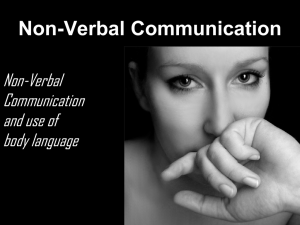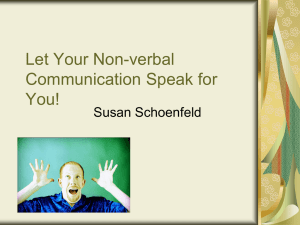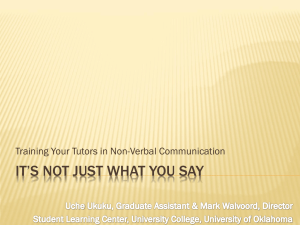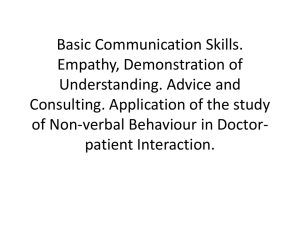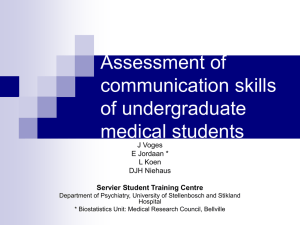types of non-verbal communication
advertisement
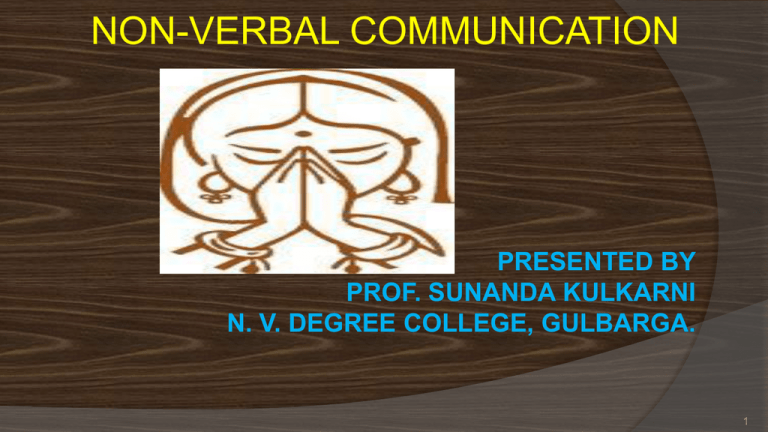
NON-VERBAL COMMUNICATION PRESENTED BY PROF. SUNANDA KULKARNI N. V. DEGREE COLLEGE, GULBARGA. 1 NON-VERBAL COMMUNICATION Non-verbal communication is communication without the use of spoken or written words. It is a process of communicating ideas or message by not using written or oral language, but through body language and facial expressions. Non-verbal communication is concerned with such things as body movements, space, time and voice rhythm as well as general features of the environments- color, layout, and design. 2 TYPES OF NON-VERBAL COMMUNICATION:The types of Non-verbal communication are as follows: 1.Kinesics- [the study of body movements] e.g. Facial expressions and eyes, Gestures, postures, and Appearance. 2. Proxemics-[the study of space or distance adopted by the speakers]. 3. Paralanguage-[the study of voice quality used by the speakers]. 4. Physical context-[the study of color, layout and design]. 3 1KINESICS-may be defined as the study of the body’s physical movements. In the process of Kinesics, we look for inner states of emotion as expressed through different parts of the body and their physical movement. Let us see how different parts of the body send out different messages A] Facial Expressions and Eyes: Facial expression may express happiness, anger, shyness, sadness, fear etc. The eyes tell us much more than other facial features. Following are few examples of facial expressions and their interpretations. 4 5 6 Expressions No eye contact Half raised eyebrows Closed eyes Pursed lips Raised eyebrows Smiling face Roving eyes Shifting eyes Interpretation Disinterest Worry Desire for privacy Lackofopenness/disapproval/dislike Disbelief/inquiring/surprise Friendliness Arrogance and power Hiding something 7 Clicking of fingers Clicking of tongue Drumming/ Tapping Hanging head Licking lips Scratching head Shaking head Shrugging shoulders Stamping foot Trying to remember Annoyed Impatient Ashamed Anticipating puzzled disagreement doubt, indifferent angry 8 Wrinkled nose dislike, distaste Wrinkled forehead puzzled. Nodding Assent or tolerance Steady eye contact Active listener Biting of lips Nervous Clenching of fists Angry, aggressive Examples: She bit her lips nervously. He scratched his head and looked thoughtful. She raised her questioning eyebrows. [ Note: The combination of the verb and part of the body convey’s an emotion or attitude.] 9 B] GESTURES: Gestures too play a significant role in making the communication effective. Gestures are the physical movements of the body parts like arms, legs, hands, head etc. According to Roger E Axtell, ‘Without Gestures, our world be static, colorless……We use gestures almost instinctively’. All oral communications are accompanied by gestures such as shrugging of the shoulders, flourish of the hands, movement of the head etc. In fact, without the accompanying gestures it would be difficult to speak. These gestures enhance the impact and add a greater value to what is being said. 10 11 Gestures Arms folded on chest Fists clenched Running fingers through hair Hand over mouth Frown Uncrossed legs Open hands, palms up Nodding Possible Meanings not going to listen defensiveness frustration doubtful displeasure open to agreement sincere, open agreeing 12 Thumbs up job well done Moutza (opening your palm,streching out fingers)I’m not particularly impressed) The dog call (index finger towards you in summoning position)-target men to follow them The A-OK-great/absolutely fine/ you think they are a zero V-sign –victory Fig-thumb poking out from between the index and middle finger-encourage good luck The Corna –players indicate two outs The middle finger-one fingered victory salute 13 C] POSTURE: It is an important part of body language and generally refers to the way one stands, sits and walks. The movement of the body, the position of hands and legs and other parts of the body reveal an individual’s personality-whether he is vibrant, alive and dynamic, nervous and jittery, confident and self-assured. A good speaker stands tall, feet together. A drooping shoulder and a protruding stomach indicate that the speaker is tired and worn out. The posture of sitting with stretched out legs shows confidence and relaxation. 14 While different situations will demand different sitting postures, one should keep one ’s back straight from the waist up, both the feet should be on the floor, one slightly in front of the other. The ability to walk across the stage with ease and grace contributes a great deal to the first impression the speaker makes upon his audience. The walking posture may convey whether a speaker is confident, energetic and vital or withdrawn, diffident or nervous. 15 To walk gracefully 1. Move the legs freely from the hips. 2. Lift your feet from the floor. Do not drag them. 3. Walk in straight line. Avoid a stride or taking tiny steps. 4. While speaking, there need to be shifts in the postures. 16 17 Five postures for the hands in worship 1] Receive-[Two-handed; hands raised, palms facing inward] It’s a posture for receiving from God a touch, a work of grace, or a gift. Fill me now, or purify my heart. 2] Stand-in-awe[Two-handed; hands raised, palms facing outward]. Nothing is held back. 3] Surrender-[same as above position]. Universal expression of surrender-I give up. 4] Testimony-[one hand raised, palm facing outward]I swear to tell the whole truth, nothing but truth. 5] Commitment/Volunteer-[same as above]I volunteer-I will 18 PERSONAL APPEARANCE: The first impact on the audience is created by the personal appearance of the speaker. By appearance , we mean clothing, hair style, ornaments, make-up and the like. Even before a single utterance is uttered an audience forms an opinion about the speaker. It may put the audience into a resistant or even a hostile attitude. It may also induce a receptive mood. Hence in respect of certain communication situations such as interview, convocation, professionals, state banquet etc. certain conventions with regard to dress have been established. Uniforms have been introduced in number of institutes. It definitely instills a sense of oneness and indicates the kind of work one does. It may be the marker of status as well. 19 20 EYE CONTACT: Eye contact with the listener is perhaps the most important aspect of the body language. Eye, is considered to be the extension of the brain and a window of the soul. And eye contact definitely is a means of gaining feedback, enabling the speaker to alter, adjust and reframe his message while transmitting it. Better eye contact leads to more effective communication. A good speaker will always look at all sections of the audience. If the audience is continuously ignored, then there is every possibility that it may lose interest 21 PROXEMICS: The term ‘Proximity’ comes from an English word ‘proximity’ which means nearness. Proximics is the personal space language. It is the study of how we communicate with others by adopting the distance between us and the listener. Edward T. Hall coined air bubble or spaces as ‘proxemics’ and explains the following four types of informal spaces to know human relationship: 1 Intimate distance-space adopted would be around 6 to18 inches.[for embracing, touching or whispering] 2 Personal distance- 18inches to 4 feet.[for interactions among good friends or family friends] 3 Social-4 to 12feet.[for interactions among acquaintances] 4 Public- 12 feet to 25 feet range of eyesight and hearing.Used for public 22 speaking The definitions of each can vary from culture to culture.Such variations can lead to confusion,discomfort,and misunderstanding. Proximics becomes truly interesting when individuals from different cultures interact. For example: South Americans and Arabs-prefer very close proxemic distances for interaction. Asians-prefer greater proxemic distance. Indians-when very close relatives or friends stand or sit very close seem to be comfortable. But we are uncomfortable if a stranger or a mere acquaintance does so. Note: The messages that we send to each other when we break or do not break these spatial boundaries. Maintaining these proxemic distances is innate. That is, we naturally keep the correct distance for each relationship. If someone in the relationship breaks the boundary of the appropriate zone, the other person will probably feel uncomfortable and become conscious. 23 24 This is termed as social distance. This term also includes a reference to the standing-seated position. The person who is in the superior or commanding position, usually stands and the others remain seated. In public gatherings one can prove more effective if one stands while speaking. Space distancing differs from culture to culture. Care should be taken to use the appropriate symbols in crosscultural contexts. However, in heightened emotional states of mind[e.g. anger, shock, danger],the normal distancing is ignored. 25 Paralanguage: is non-verbal because it does not consist of words. It shows on “how” of speakers voice rather than “what” of the words. Speaker uses a range of sign and signal.Ex: Sighing, clearing throat, yawning, clicking tongue. It includes tone of voice, pitch, volume, rhythm, pause etc.It directly influences the meaning part. Ex: uhhuh[means I’m listening to you.]ah-hah,un-huh and huh-uh. 26 Physical Context: Refers to colour, design /layout, symbols in which we communicate.It is a part of non-verbal communication because we derive meaning from our surroundings. We associate certain colours with certain situations. Ex:white stands for purity. Green symbolises life. Lee Mc Gaan has pointed out six kinds of contexts: Physical context [material objects surrounding you] Innercontext [feelings,thoughts,sensations and emotions] Symbolic context [includes all messages,primarily words-which occur before or after a communication] Relational context [e.g.father-son,student-teacher,expert-layman,friendfriend] Situational context [studying, playing a game,helping a friend with a problem.] Cultural Context [ the rules and patterns of communication that are given by[learned from] our culture and which differs from other cultures . E.g. American,Japanese,British etc.Such variations may lead to confusion, discomfort,and misunderstanding. 27 Thus, we find that up to 93% of communication effectiveness is determined by non-verbal cues. Another study indicated that the impact of a performance was determined 7% by the words used,38 % by voice quality, and 55% by the non-verbal communication. If you want to mask your feelings or your immediate reaction to information, you may have your voice and words under control, but your body language including the tiniest facial expressions and movement, can give your true thoughts and feelings away. Especially to a skilled reader of non-verbal cues, we are really open books. TIPS FOR UNDERSTANDING Non-Verbal Communications:1. Listen with your eyes: Every gesture is something if you are listening with your eyes. 2.You can read volumes from how the applicant sits in the lobby. 3.Non-verbal may reveal more than the persons spoken words. 4.At a meeting , non-verbal communication will tell you thati] you have talked long enough. ii] that someone else wants to speak. iii] the mood of the crowd and their reaction to your remarks. iv] listen to them and you’ll be a better leader and speaker. 28 29

